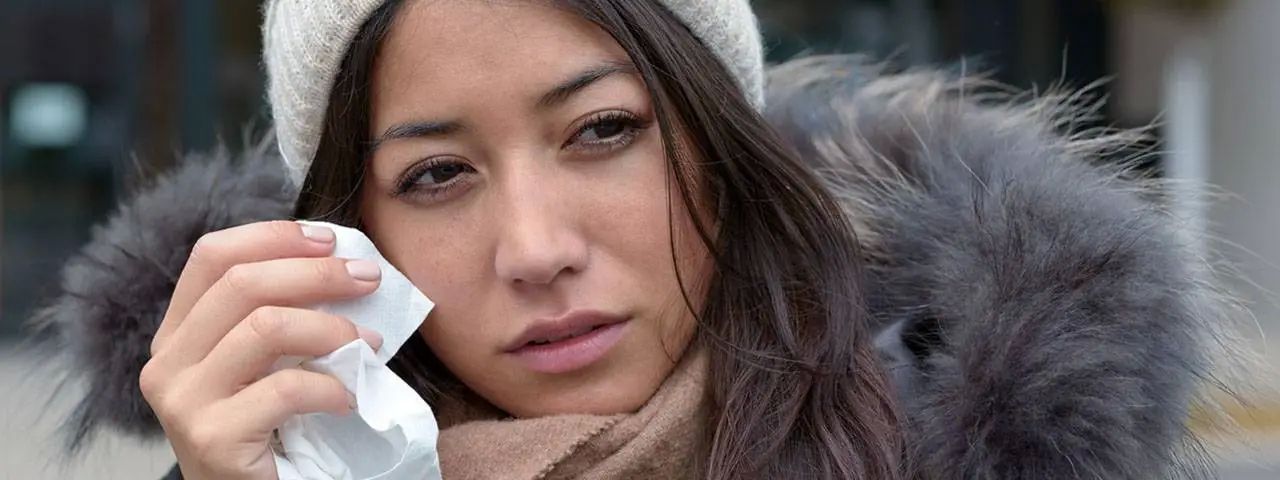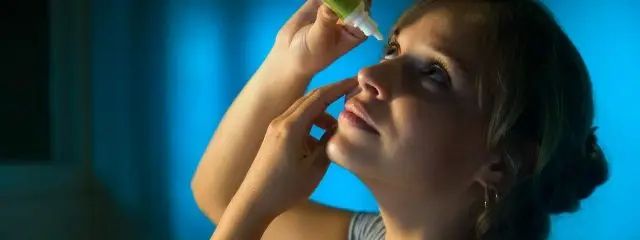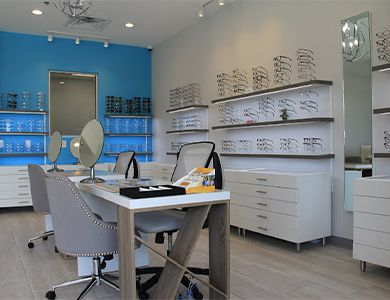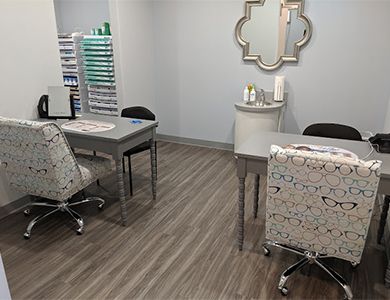Dry eye syndrome (DES) is a chronic condition that develops when your eyes do not produce and maintain enough tears to keep the eye’s surface lubricated resulting in multiple symptoms that range from person to person. This can be due to a reduction in tear production or increased tear evaporation from a lack of lipid in the tears that stem from oil glands in the eyelids. The effects can range from minor dryness and discomfort to pain, blurred vision and frequent infections.

Symptoms of Dry Eye Disease
Symptoms of dry eye syndrome can vary depending on the severity of the condition but can include:
- Dry, itchy eyes
- Burning or stinging
- Irritation
- Watery eyes
- Blurred vision
- Pain
- Foreign body sensation
The main function of tears is to maintain the health of the cornea of your eye by washing away foreign matter and ensuring that the surface of your eye remains moist, smooth and clear.
Tears also rinse away dust particles from your eyes and contain enzymes that protect your eyes from bacteria that can cause infections. Dry eyes is a condition that develops when the amount of tears produced is not sufficient to maintain the moisture balance in your eye.
This can result in that scratchy sensation, a continuous feeling of dryness, stinging and a sensation of a foreign body in your eye. Ironically in an effort to fight off the condition, dry eyes can cause you to produce excessive tears, which is why some people experience watery eyes.

Causes of Dry Eye Disease
Dry eyes can occur naturally as a result of aging or hormonal changes, typically in women who are pregnant, taking oral contraceptives or going through menopause.
In fact, women over 50 have a 50% greater risk of dry eye disease than men do of the same age.
It can also result from taking certain medications that reduce tear production such as antihistamines, blood pressure medications and antidepressants.
Environmental factors can also play a role in drying out the eyes and DED is common in areas where the climate is dry, dusty and windy.
Home air conditioners or heating systems and excessive time spent staring at a computer or television screen can also dry out eyes and exacerbate symptoms due to the lack of blinking while staring at our screens.
Individuals that suffer from certain medical conditions such as diabetes, blepharitis, lupus, arthritis and thyroid problems are more vulnerable to developing DED.
Other causes can be due to eye surgery including LASIK, certain conditions in which the eyelids don’t close properly or extended contact lens use.

Diagnosis of Dry Eye Disease At Our Frisco Eye Care Center
Typically, dry eye disease can be diagnosed through a comprehensive eye exam and a description of your symptoms. On some occasions, the eye doctor might decide to do a test that measures how quickly your tears evaporate from the surface of your eye.
By instilling a simple dye called fluorescein (much like food coloring) the doctor is able to watch and count how long it takes the tears to start to break up after they’ve asked you to hold your eyes open after a blink.
This is called TBUT or a Tear Break Up Time test. A low TBUT generally indicates a lipid (aka oil) deficiency in the tears resulting from oil glands in the eyelids not functioning properly.
In another type of test, called a Schirmer test, a strip of filter paper is placed under the lid of the eye and you will be asked to close your eye for five minutes.
Following the test the amount of moisture on the strip will be measured. Schirmer tests are performed less frequently than a TBUT test.

Treatment for Dry Eyes
There are many treatment options for dry eyes which are highly dependent upon the cause and severity of the condition. Many mild forms of DED can be alleviated using artificial tears or lubricant eye drops to make up for the lack of natural tears usually produced by your eyes.
If over-the-counter drops don’t alleviate your symptoms, our Frisco optometrist might prescribe prescription drops that actually stimulate tear production or steroids for short-term relief.
More severe cases of dry eyes might be treated with a punctal insert which is a tiny insert containing a slow-release lubricating substance that is placed inside the lower eyelid.
Since DED is often related to eyelid inflammation known as blepharitis Dr. Jones may prescribe a heated hot compress mask, specialty eyelid scrubs, and sometimes an antibiotic ointment. Finally, punctal plugs might be recommended for severe cases which would be inserted into the tear ducts to reduce the tear drainage in your eyes to keep them from drying out.
In cases where discontinuation or switching to different medications is possible, this can eradicate symptoms. Our Frisco eye doctor may also recommend that you limit or refrain from contact lens use for a certain amount of time or switch to a different brand or type of contact lens which will reduce dehydration.
Ask us about Envision Radiofrequency, an amazing option for dry eye treatment!

Preventing Dry Eyes
If the cause of your dry eyes is something external or environmental, eliminating that cause may solve the problem and resolve the symptoms.
Avoid dry environments, hair dryers, heaters and fans, (particularly directed toward the eyes) and smoky environments and wear eye protection such as wrap around glasses or goggles when in dusty or windy areas.
Use a humidifier to add moisture to dry indoor air. If working on computer or watching television, make sure to blink purposefully as our natural tendency is to reduce our blink rate when staring at a screen.
Also avoid rubbing your eyes as this can further irritate them. Staying hydrated by drinking at least 8 to 10 glasses of water per day can also help.
Dry eye disease won’t have a permanent effect on your vision, but there is no reason to endure dry, itchy and uncomfortable eyes, especially since there are so many treatment options to increase moisture and comfort.
It’s also important to realize that this is a chronic disease that needs consistent treatment. Our Frisco eye care expert will work with you to create a long term strategy to keep your eyes as comfortable as possible.
Treating any underlying eyelid disease, such as blepharitis, helps as well. This may call for antibiotic or steroid drops, plus frequent eyelid scrubs with an antibacterial shampoo.
If you are considering LASIK, be aware that dry eyes may disqualify you for the surgery, at least until your dry eye condition is successfully treated. Dry eyes increase your risk for poor healing after LASIK, so most surgeons will want to treat the dry eyes first, to ensure a good LASIK outcome. This goes for other types of vision correction surgery, as well.
Additional Treatment At Contact Lens & Eyecare Gallery
We provide different medications to combat dry eye.
Omega-3s are clinically proven to improve dry eyes.
Physician Recommended Nutriceuticals (PRN) sell Dry Eye Omega Benefits, a dietary supplement of fish oils, that can drastically improve your dry eye symptoms. PRN's Omega-3 supplements are easier to digest than over the counter supplements and do not come with a fishy aftertaste. You may not see improvement for about 60-90 days, but the Omega-3s are working inside your body before you notice the outward result.
More info to come on Envision Radiofrequency.
Bruder Moist Heat Eye Compress opens oil glands and allows natural oils to flow back into the eye relieving discomfort from aging, contact lenses, use of digital devices and more.
The easy-to-use compress delivers an effective moist heat treatment. The mask is very simple to use, just microwave for 20-25 seconds and apply for about 10 minutes or as prescribed by your doctor.
The compress helps stabilize the tear film, improves oil gland function and slows tear evaporation. Properly hydrated and lubricated eyes can expel bacteria and debris more efficiently so your eyes will feel refreshed and rejuvenated.
- Safe for frequent use
- Self-hydrating – no need to add water
- Anti-bacterial and non-allergenic
- Washable and reusable.
The mask has a patented design for optimum conformance and comfort. Unique pod design provides improved fit and performance. It is also available in a single eye model.
Tea tree oil can help improve dry eye syndrome. The oil improves tear film stability.
Xiidra® (lifitegrast ophthalmic solution) 5% is a prescription eye drop used to treat the signs and symptoms of dry eye disease. *Note: Do not use Xiidra if you are allergic to any of its ingredients. Seek medical care immediately if you get any symptoms of an allergic reaction.
5 Facts About Xiidra
Use Xiidra twice per day: Use one drop of Xiidra in each eye, two times a day, about 12 hours apart.
Wear contact lenses?: Take ’em out before using Xiidra and wait at least 15 minutes before popping them back in.
Single-dose containers: Each Xiidra container has enough medicine to treat both of your eyes once. So you’ll be using two containers each day, about 12 hours apart.
Scrub those hands: To avoid contamination, wash your hands first & don’t let the tip of the container touch your eye or any surface.
Have bad aim?: It’s ok! Each container has some extra solution in case you miss. Throw it out when you’re done – don’t save it.
RESTASIS® and RESTASIS MultiDose® drops help increase your eyes’ natural ability to produce tears, which makes it a top treatment for dry eye.
Do not use RESTASIS® and RESTASIS MultiDose® Ophthalmic Emulsion if you are allergic to any of the ingredients. Be careful not to touch the container tip to your eye or other surfaces, to help avoid eye injury and contamination. RESTASIS® and RESTASIS MultiDose® should not be used while wearing contact lenses. If contact lenses are worn, they should be removed prior to use of RESTASIS® and RESTASIS MultiDose® and may be reinserted after 15 minutes.
The most common side effect is a temporary burning sensation. Other side effects include eye redness, discharge, watery eyes, eye pain, foreign body sensation, itching, stinging, and blurred vision.




